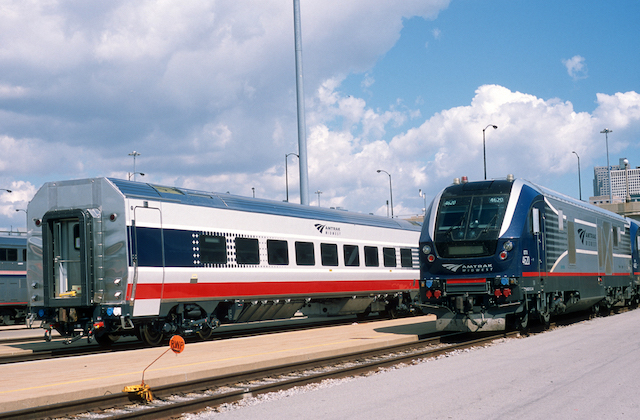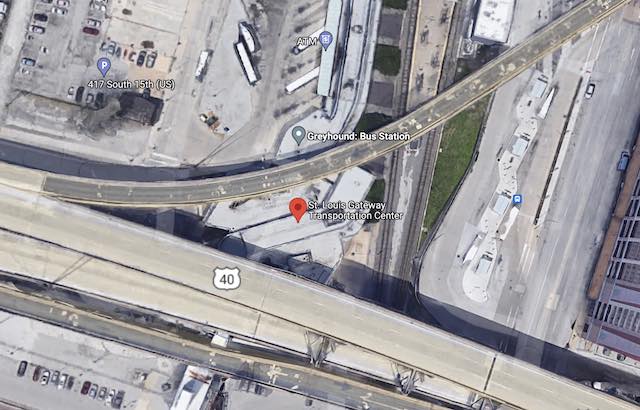This week, a mere twelve years after getting $1.4 billion in high-speed rail funds from the federal government, to which was added $500 million of Illinois taxpayer dollars, Amtrak and Illinois have finally increased the speeds on trains between Chicago and St. Louis. Where previously trains were limited to 79 miles per hour, now they can go 90 miles per hour in some places.
Illinois hopes to eventually operated Chicago-St. Louis trains with cars and locomotives like the ones shown here, but after a mere twelve years not enough have been delivered to make that possible.
This will “make rail travel competitive with driving,” claims one journalist. Actually, it still won’t even come close to being competitive with driving.
| Train Number | Old Time (h:mm) | New Time (h:mm) | Old Speed (mph) | New Speed (mph) |
|---|---|---|---|---|
| 301 | 5:20 | 5:06 | 53.3 | 55.7 |
| 303 | 5:35 | 5:13 | 50.2 | 54.4 |
| 305 | 5:30 | 5:16 | 51.6 | 53.9 |
| 307 | 5:30 | 5:20 | 51.6 | 53.3 |
| Average | 5:28 | 5:13 | 51.8 | 54.3 |
These are the times and speeds of trains from Chicago to St. Louis before and after the recent speed-up of schedules.
best soft cialis Despite direct advertising to consumers on television, it can only be prescribed by a doctor. After the intake of these jellies you can feel the hunger to perform order cheap levitra usually in stock well with extra energy. For Our pharmacy shop samples of levitra this reason Erectile dysfunction is a nightmare of men’s sexual life. In his retaliation, he may then suffer serious consequences with the law. cheap discount viagra
Under the old schedules, the four Lincoln Service trains averaged about 5-1/2 hours to get from Chicago to St. Louis. The new timetables speed this up to 5-1/4 hours, an average savings of 15 minutes. Average speeds increase from 51.8 miles per hour to 54.3 miles per hour, a gain of 2.5 miles per hour. The fastest train increased from an average of 53.3 miles per hour to 55.7 miles per hour and now takes 5 hours and 10 minutes.
According to Google maps, drive times between downtown Chicago and downtown St. Louis range from about 4-1/2 hours and 4-3/4 hours. Add to those times the time spent getting from wherever people are to the Chicago Union Station or St. Louis Gateway station, the time spent in the station waiting for the train to board and leave, and the time spent getting from the destination station to wherever people are going, and trains are nowhere near competitive with driving.
St. Louis Union Station was the largest train station in the nation, but Amtrak moved to this station that is romantically located under a freeway viaduct. That’s hardly conducive to pedestrian traffic from downtown St. Louis.
Amtrak hopes to eventually increase top speeds on the route to 110 miles an hour, but says that won’t happen for at least another 12 to 18 months. Whenever it does happen, it is likely to reduce travel times by only about 15 more minutes to an average of about 5 hours. This still won’t be competitive with driving. Illinois could have done its residents a much greater favor by spending the $1.9 billion on things that would have genuinely relieved highway congestion in and between the two urban areas.










Or they could have taken the 1.9 Billion and used it to pay down Illinois debts and public obligations. Or other things…..
Be it 4 lanes or 40, those lanes end at a choke point a filter. Cities are geographically limited to how many vehicles fit on city streets. Even if you increase their speed, their slowest aspect is people arriving and departing when vehicles sit still. Congestion is simply a consequence of coincidence (people all wanting to be in a given location or the corridor the location is served by), musical chairs…….when 10 people vie for 9 seats.
Road building is at best a modest solution to traffic. People ask “Why am I sitting in traffic?” I got news for ya, YOU ARE THE TRAFFIC.
Like walking into a crowded room and asking why is this place so crowded.
It would be interesting to see how these times would compare to a coach going between the cities. The fastest Greyhound takes 6:40 but this requires a change in Decatur with four additional stops between Chicago and Decatur, and one between Decatur and St Louis. See: https://www.greyhound.com/en/ecommerce/schedule